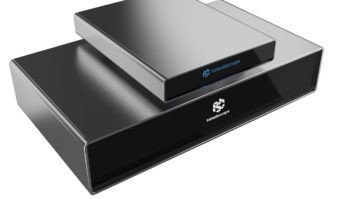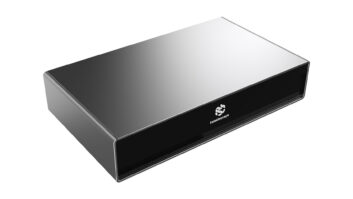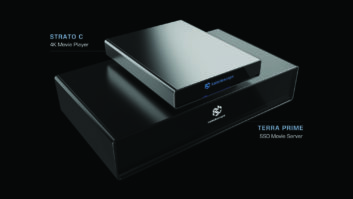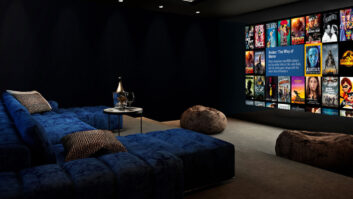Even though I live with a Kaleidescape movie server and use the system almost every day, it becomes such a part of your lifestyle that it is easy to take it for granted and forget how the rest of the world selects and watches movies. It really isn’t until I demo the system to guests at my house or to prospective Kaleidescape buyers at my showroom that I really remember how the other half lives (ie: watches movies.)
At this year’s CEDIA EXPO, Kaleidescape’s CEO Cheena Srinivasan, held a dealer meeting where he shared something that encapsulates the Kaleidescape experience. Cheena told dealers that the company concerns itself with the experience that a user has before and after watching the movie.

According to Cheena, the average Kaleidescape customer has 506 movies in his or her home and, “How people decide what to watch with family and friends before pressing play” is what makes Kaleidescape so exceptional. And after a giving a recent demo to a customer, it really hammered that point home for me.
Once you get into the film and are actually watching the movie, there is no real difference between a Kaleidescape system and a regular, high-end Blu-ray player. But, as Cheena said, it’s all of the things that happen before and after someone presses “Play” that makes the difference. And when you think about how most people interact with and experience their movie collections, it’s easy to see why a movie server like Kaleidescape is such a terrific alternative. As Cheena said, “Kaleidescape is for customers seeking the best movie watching experience and who are dissatisfied with watching movies in poor quality on their large-screen TVs.”
For most people, watching a movie involves a whole process before the film begins. This typically includes getting up and digging through a pile of discs in a cabinet or box somewhere or looking at stacks of disc cases like browsing for a book in the library or searching through some kind of Excel list. If they’ve been diligent about sorting their collection, then maybe the discs will be in some kind of order. Otherwise, they’ll probably be hard pressed to find exactly what they want, let alone remember all of the movies that they’ve purchased over the years.
Once they find a disc and put the movie into the player, they’ll have to wait the random period of time for the disc to load, wade through the trailers—interesting in an academic, time-travel sense to see the “coming soon” ads for a movie that was released 15 years ago—before they get into the movie’s menu, select the preferred audio track, and then FINALLY watch the movie.

Contrast that with how a Kaleidescape user watches movies. First, the user is presented with their collection in a variety of high-def, eye-candy manners, whether on their big-screen TV or via an iPad app. However they prefer to browse—cover art, sortable lists, or collections—the system helps them to explore, enjoy, and rediscover their collections.
With close to 400 films in my collection, I can’t remember all of the movies I own, especially because I own quite a few movies that I’ve picked up at tradeshows over the years. (Thank you, DEG!) I frequently browse my collection by cover art, similar to taking a stroll through what-used-to-be-Blockbuster and checking out what is on the shelf. As I scroll through my collection, I’m reminded of what I own, and this is frequently how I find movies I’ve forgotten about or that my family hasn’t watched in a while. Pausing on a title causes the Kaleidescape system to shuffle the covers and bring similar movies together. Stop on a James Bond movie, and other spy titles are shown. Stop on a film like Gravity and other intense dramas like The Abyss, Hunger Games, Super 8, and Crash are displayed.
When I want to hunt for something specific, I sort my collection alphabetically by title. Or by actor. Or by director. Or by rating. Or release year. Or genre. Or running time. My wife and I often start movies after 10 p.m., and it’s nice to be able to cull down your selections to movies that will get you in bed before midnight.
The Collections view lets me see just my HD titles, or any movies I’ve started but haven’t finished. (This is great for keeping track of where you are when watching a TV series). Or my concert films. Or family friendly movies that I’ve put into Lauryn’s “Kid���s Collection.” Or any other grouping that I want to create.
Pressing “Play” on a Kaleidescape automatically jumps past all of the garbage that precedes most movies; no trailers, no menus, no warnings, just straight to the film. Because honestly, when I’m re-watching The Abyss I don’t really need to know about the resolution adopted at Interpol General Assembly in Stockholm back in 1977.
Another big difference I’ve experienced with owning a Kaleidescape is what happens AFTER the movie is over. For a typical movie watcher, when the movie ends, the disc gets pulled out of the player and is returned to wherever it came from and that’s it. Movie night is over. When the movie is over with a Kaleidescape, however, a user is once again presented with their movie collection. At my house, we’ll usually continue browsing and often start something else. Or we’ll select a few “Scenes” to watch—bite-sized chunks of the most iconic moments from films hand selected by the Kaleidescape Movie Guide team. Sometimes I might just want to watch the “Tuna versus Lion” scene from The Other Guys again, or Rocky’s training montage, or thousands of other moments.
Despite all the hype surrounding streaming and digital media, physical disc purchases still make up 42 percent of Hollywood’s home video revenue and with another 22 percent coming from disc rental. Discs might be going away, but for now there is still a real need to manage them.

Cheena also wanted to make sure that dealers were fully informed about the settlement of the DVD CCA lawsuit. As part of that agreement, all Kaleidescape systems sold AFTER November 30, 2014 will be unable to import CSS-protected DVDs (virtually every “store bought” title). DVDs will still play on a Kaleidescape system, and will still include all of the rich browsing experiences like bypassing warnings and bookmarking movie scenes, but the disc must be present in the system either in the disc tray or in one of the company’s Disc Vault’s to play.
Cheena stressed that any system sold BEFORE November 30, 2014 will continue to work as it always has. If you have a customer that has been on the fence about purchasing a Kaleidescape system, you have until November 28th to place and pay for your order to make sure that it is “grandfathered” in to allow DVD importing.
Kaleidescape feels that settling the lawsuit opened the door to license content from studios for the Kaleidescape Store, and provide more Disc-to-Digital offers to purchase and download electronic versions of movies on a DVD, including upgrading to Blu-ray quality version. Cheena said that the company is “working very closely” with Hollywood studios and is “very confident” that Kaleidescape will have the rights to all major studio releases by year-end.
John Sciacca is principal of Custom Theater and Audio in Myrtle Beach, SC.







